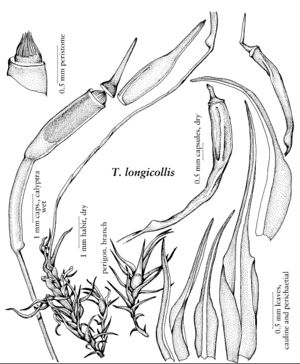Difference between revisions of "Trematodon longicollis"
Fl. Bor.-Amer. 2: 289. 1803,.
FNA>Volume Importer |
FNA>Volume Importer |
(No difference)
| |
Revision as of 21:54, 16 December 2019
Leaves ovate-lanceolate to long-subulate from an ovate or obovate base, serrulate at apex; costa percurrent or ending before the apex. Seta long, 10–30 mm. Capsule inclined, curved; neck 2–3 times as long as urn when dry, long-cylindric, strumose at base; peristome teeth 2-fid or irregularly perforate, not fragile, commonly persistent; annulus compound, revoluble.
Phenology: Capsules mature spring–summer.
Habitat: Soil, sand
Elevation: low to moderate elevations
Distribution
Ala., Ark., Fla., Ga., Ky., La., Md., Miss., N.J., N.C., Ohio, Okla., Pa., S.C., Tex., Va., Mexico, West Indies (Cuba, Puerto Rico), Central America, South America, Asia (China, Japan, Papua New Guinea), Pacific Islands (New Caledonia).
Discussion
Trematodon longicollis is much like T. ambiguus but differs in the relative lengths of capsule urn and neck when dry, and is clearly more southern in distribution. The peristome may occasionally adhere to the operculum on dehiscence and the capsule may then falsely appear gymnostomous.
Selected References
None.
